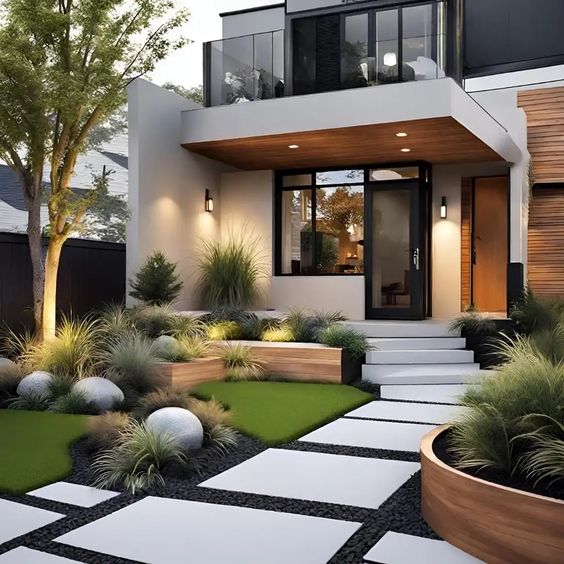Whether you’re starting from scratch or looking to renovate, crafting the ideal house is an exciting yet daunting task. We’ll explore a range of key features, from maximizing natural light to incorporating sustainable elements, and delve into various design styles, like the ever-popular modern farmhouse or the cozy charm of rustic chic. Get ready to discover clever space-saving solutions for smaller homes, luxurious touches for a touch of opulence, and inspiring ideas for every room, both inside and out. So, buckle up and prepare to be enthralled by a world of design possibilities!
ARCHITECTURAL GEOMETRY IN MODERN HOUSE DESIGN
This section examines the key architectural elements that influence both the structural integrity and visual appeal of modern house designs. Emphasizing geometric and structural features, these elements play a crucial role in defining the unique and contemporary character of these homes.
ASYMMETRICAL FACADES IN CONTEMPORARY RESIDENTIAL ARCHITECTURE

The front views of these homes feature asymmetrical designs, which add visual intrigue and a unique character to each modern residential structure. This architectural approach deviates from traditional symmetry, resulting in a dynamic and eye-catching appearance.
Asymmetry enables architects to play with light and shadow, creating facades that remain visually captivating throughout the day. This design strategy often includes unconventional placements of windows and doors, further accentuating the distinctiveness of each home.
FLAT AND LOW-PITCHED ROOFS
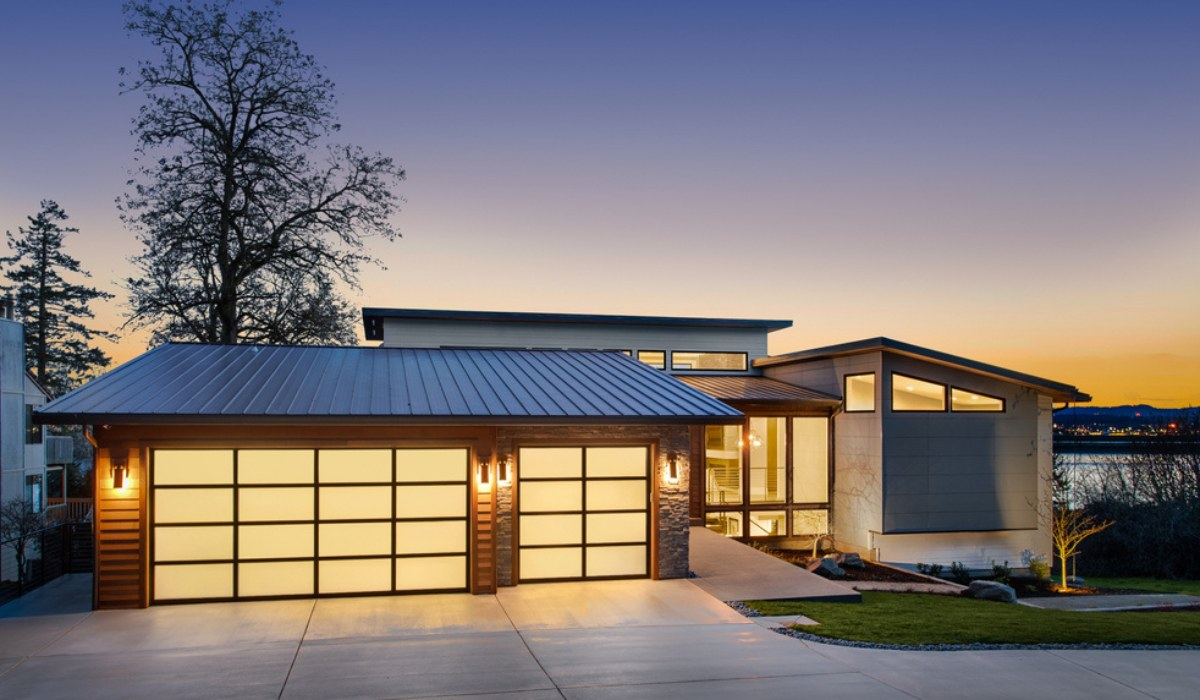
These homes often feature flat or gently sloped roofs, contributing to the sleek, modern profile that defines contemporary house decorating ideas. This design choice not only highlights a streamlined aesthetic but also makes better use of rooftop spaces, which can be adapted for terraces or green roofs.
These roof styles generally use less material compared to traditional pitched designs, reflecting a preference for efficiency and a more unobtrusive visual impact.
VARIED ROOF LEVELS
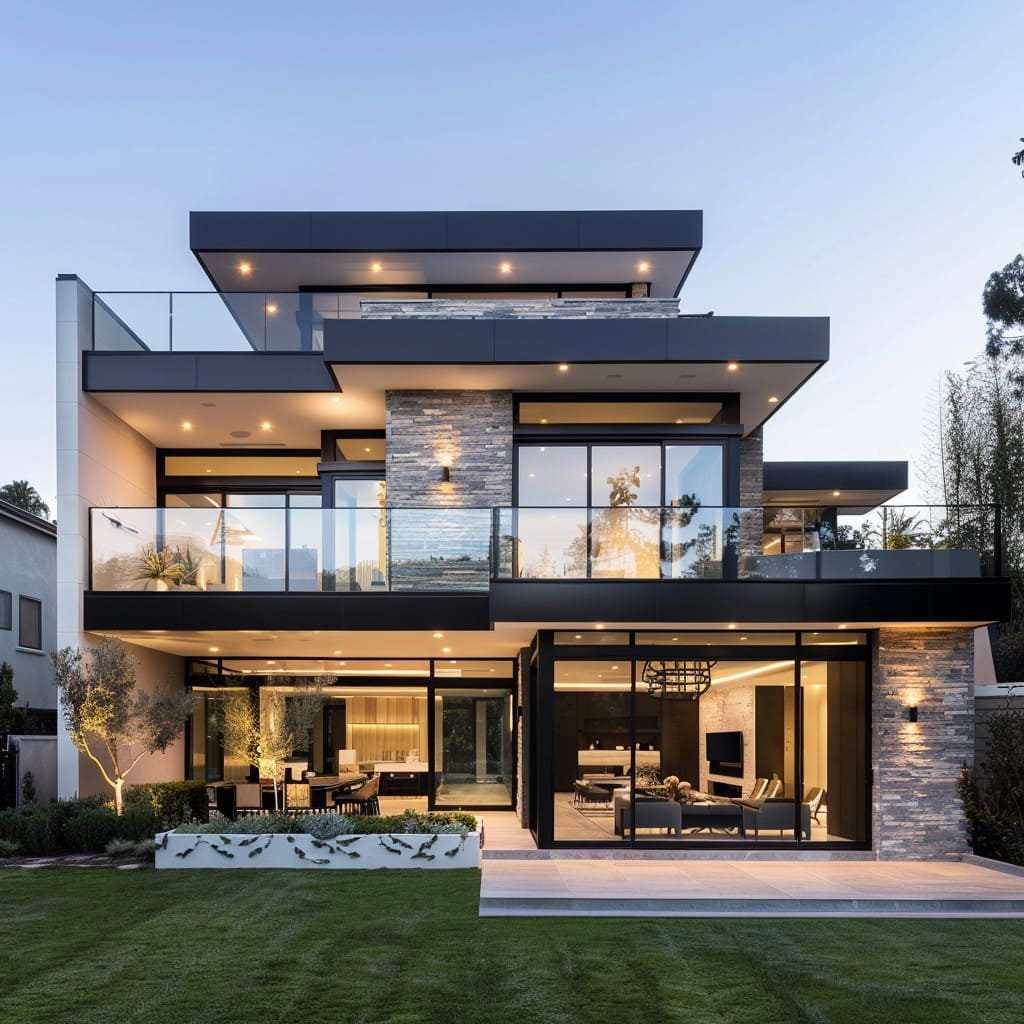

Different sections of these homes feature varied roof levels, creating a captivating layered effect that is a signature of modern dream house designs.
This height variation adds aesthetic complexity and enables diverse internal ceiling heights, which can define spaces within the home without relying on internal walls. The varied roof levels often lead to intriguing interior spaces with abundant natural light and impressive views.
ATMOSPHERIC AND AESTHETIC IMPACT
USE OF CONCRETE

Concrete serves both structural and visual purposes, enhancing the modern aesthetic of contemporary designs. Its minimalist appearance and versatility allow architects to create impactful and varied shapes and textures.
In addition to its visual appeal, concrete offers thermal benefits that improve energy efficiency by stabilizing interior temperatures. It can be left in its natural, raw state to highlight its texture or polished and finished to achieve a more sophisticated look.
DYNAMIC PLAY OF SHADOWS
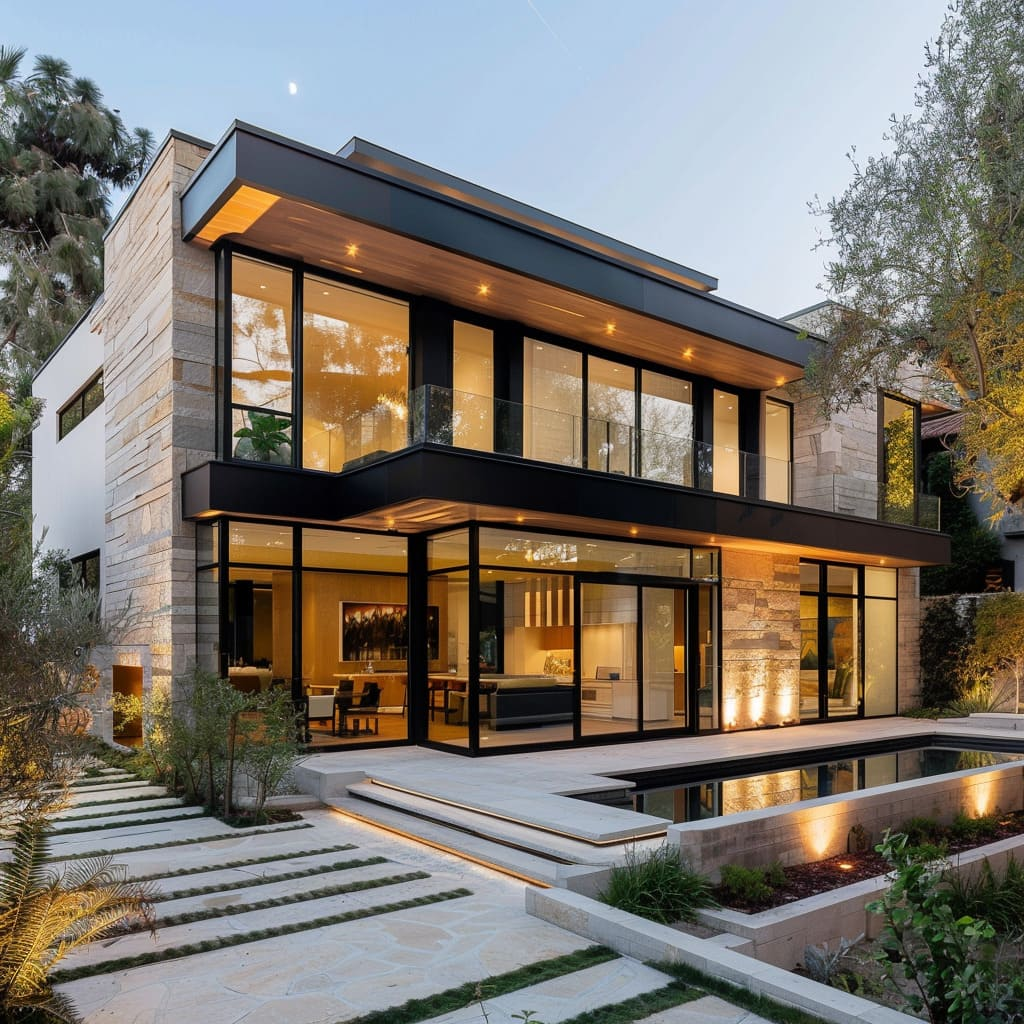
The architecture is designed to produce intriguing shadow patterns that evolve throughout the day. As the sun moves, these shadows shift across the home’s surfaces, creating a constantly changing display that emphasizes the dynamic quality of the design.
This effect is especially striking in homes featuring bold geometric shapes and overlapping structural elements, where the interplay of light and shadow enhances the facade with added depth and movement.
VARIED WINDOW SIZES
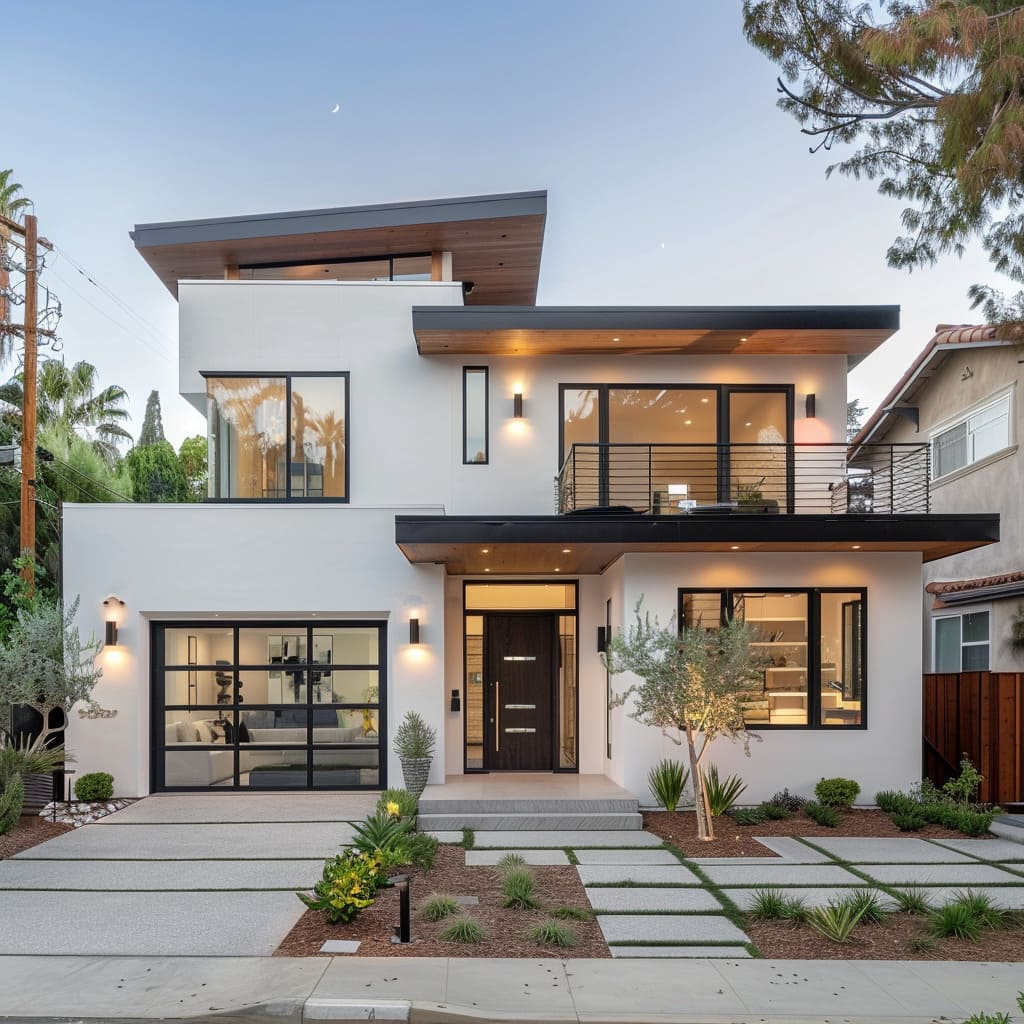
A combination of large and small windows disrupts monotony and caters to specific interior lighting needs. This architectural choice facilitates controlled lighting in various parts of the house, improving both functionality and ambiance.
Larger windows are often used in living spaces to provide expansive views and ample natural light, while smaller windows are strategically positioned in private areas to offer illumination while preserving privacy. This variation in window sizes also creates a visually engaging rhythm on the home’s exterior.
FEATURE FIREPLACES

Outdoor and indoor fireplaces act as focal points for both gathering and visual appeal. These fireplaces often become the heart of the home, offering warmth and a natural spot for family and friends to congregate.
In outdoor areas, fireplaces enhance the usability of gardens and patios during cooler evenings, creating a welcoming atmosphere. Inside, a thoughtfully designed fireplace can anchor the living space, captivating with its striking design and the warmth it delivers.
Materials such as stone, metal, and ceramic are commonly selected for their durability and ability to harmonize with the home’s overall style.
STRIKING NIGHTTIME APPEAL
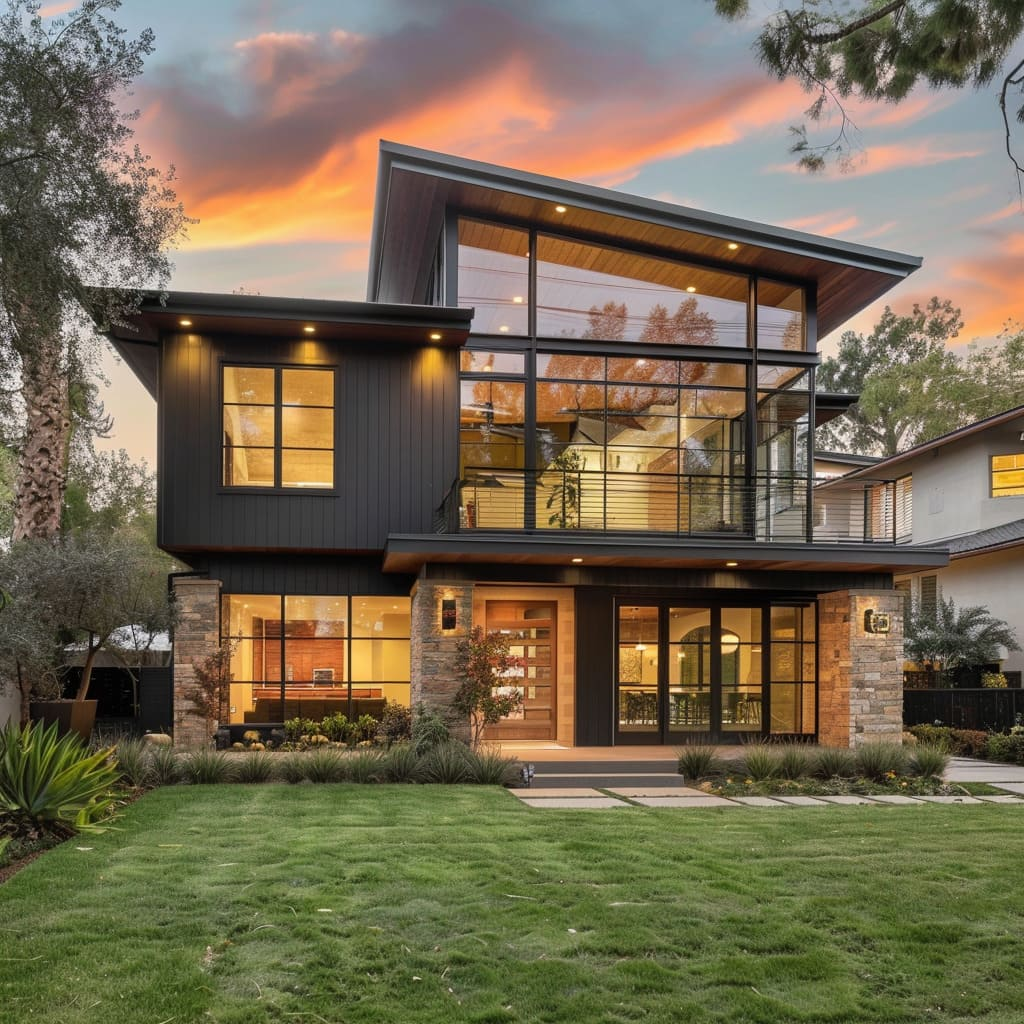
These homes are crafted to be exceptionally eye-catching after dark, with both interior and exterior lighting accentuating their design.
The captivating nighttime look is achieved through a thoughtfully arranged lighting scheme that highlights architectural lines and surfaces, turning the home into a radiant spectacle. Accent lights may illuminate pathways and emphasize facade textures, while soft ambient lighting inside creates a warm glow visible through large windows.
This strategic lighting approach not only enhances security but also transforms the home into a standout visual landmark after sunset.
SEAMLESS INTEGRATION WITH NATURE AND OUTDOOR FEATURES
This section emphasizes the seamless integration of natural elements and outdoor features, showcasing how modern homes merge indoor and outdoor living spaces. This design approach enhances the overall living experience and fosters a stronger connection to the surrounding environment.
EXPANSIVE BALCONIES

Large balconies extend indoor living spaces into the outdoors, offering a comfortable and versatile area. Designed with protective railings and overhead coverings, these balconies ensure safety and weather protection.
Balconies can serve various functions, from a tranquil reading spot to an alfresco dining area, and often feature amenities like built-in seating and space for container gardens. Their design typically mirrors the interior style, ensuring that these outdoor areas seamlessly complement and enhance the overall aesthetic of the home.
INTEGRATED GREEN SPACES
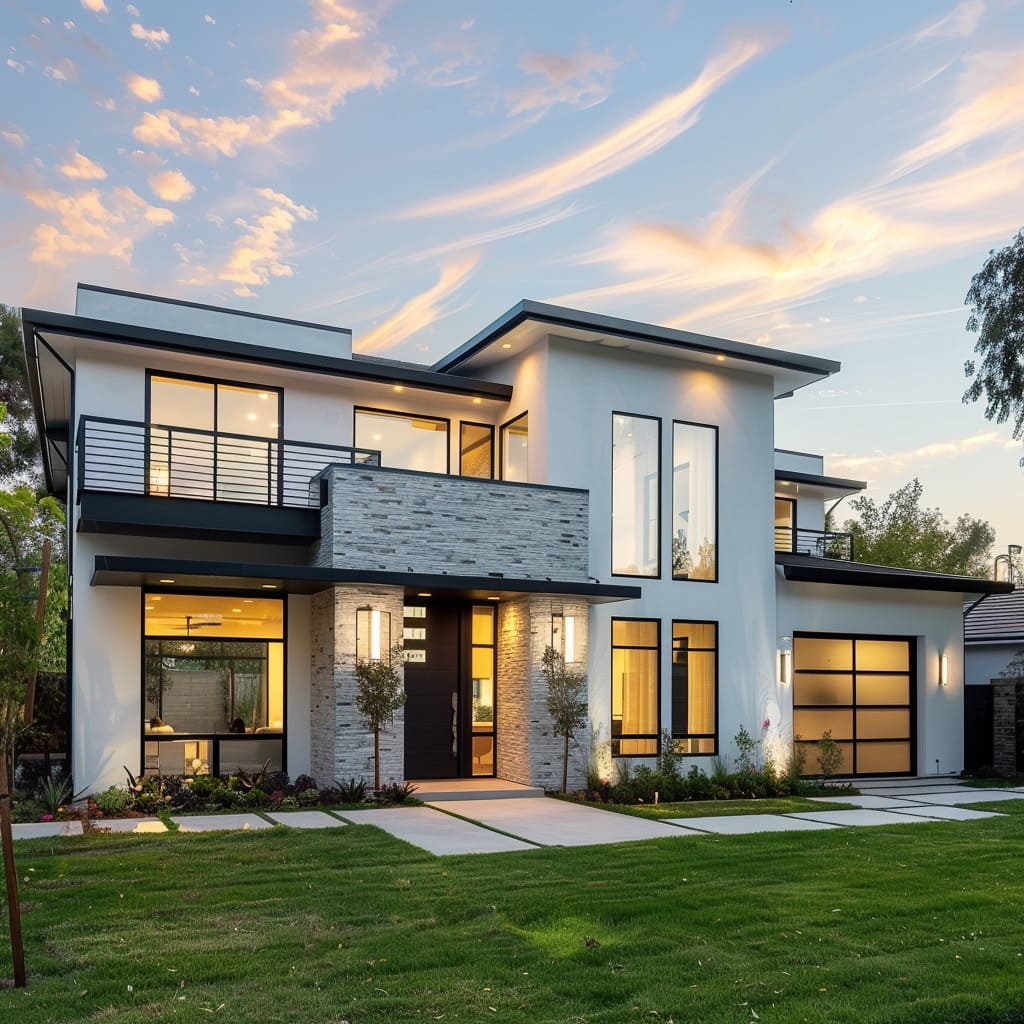
Small gardens and landscaped areas are thoughtfully integrated into the design, infusing residential spaces with a touch of nature.
These green spaces not only enhance the visual appeal but also support ecological health by providing habitats for local flora and fauna. Strategically arranged plants help moderate home temperatures, reduce noise levels, and improve air quality, combining functionality with beauty. Balconies, serving various purposes from quiet reading nooks to alfresco dining areas, are designed with amenities like built-in seating and space for container gardens. Their design seamlessly extends the indoor living space, with materials and finishes that reflect the home’s interior style.
WATER FEATURES IN MODERN ARCHITECTURAL DESIGN
Many modern homes feature water elements such as fountains and reflective pools, which contribute to a serene and luxurious ambiance. The gentle sound of flowing water adds a calming quality to the environment, masking city noise and creating a tranquil retreat.
These water features are often strategically positioned to be visible from various points within the house, allowing the soothing effects to be enjoyed both indoors and outdoors.
LARGE OUTDOOR SPACES
Spacious patios and decks are a hallmark of modern home designs, offering expansive outdoor living areas that align with a luxurious lifestyle. These versatile spaces are designed to support various activities, from relaxing morning coffees to lively social gatherings.
The design typically incorporates durable, weather-resistant materials and carefully considered landscaping to create an inviting and practical environment. Stylish furniture and a well-planned layout further enhance comfort and usability, ensuring these outdoor areas are both functional and visually appealing.
PROMINENT USE OF GLASS
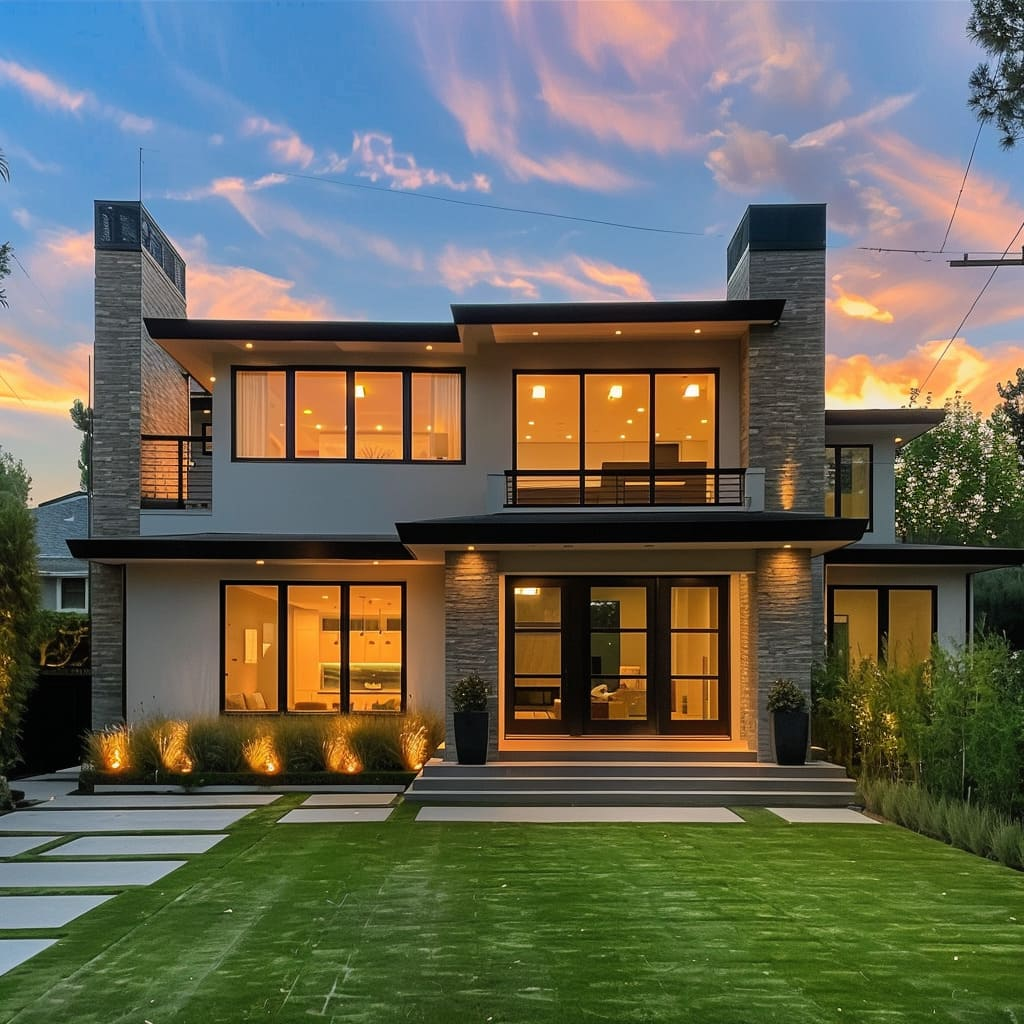
Large glass windows and doors are key elements that enhance the sense of openness in modern homes, blending the natural scenery with the interior seamlessly.
This design choice effectively blurs the line between indoor and outdoor spaces, bringing the landscape into the living areas. The extensive use of glass maximizes natural light, reducing reliance on artificial lighting during the day and offering unobstructed views that expand the visual space of the interior.
FACADE AND EXTERIOR DESIGN
This category explores the materials and design elements that define the exterior facade of the house, highlighting how these features enhance the home’s modern aesthetic and curb appeal.
UNIQUE CHIMNEY DESIGNS
Chimney structures are often designed as prominent focal points on the exterior, serving both functional and aesthetic purposes.
These chimneys typically feature bold shapes and materials that reflect the modern design ethos of the home. They may be clad in the same stone as the facade or showcase contrasting materials such as metal or colored render. This design approach not only draws the eye upward but also highlights the home’s verticality, making the chimneys standout elements in the overall architectural composition.
ACCENT WALLS
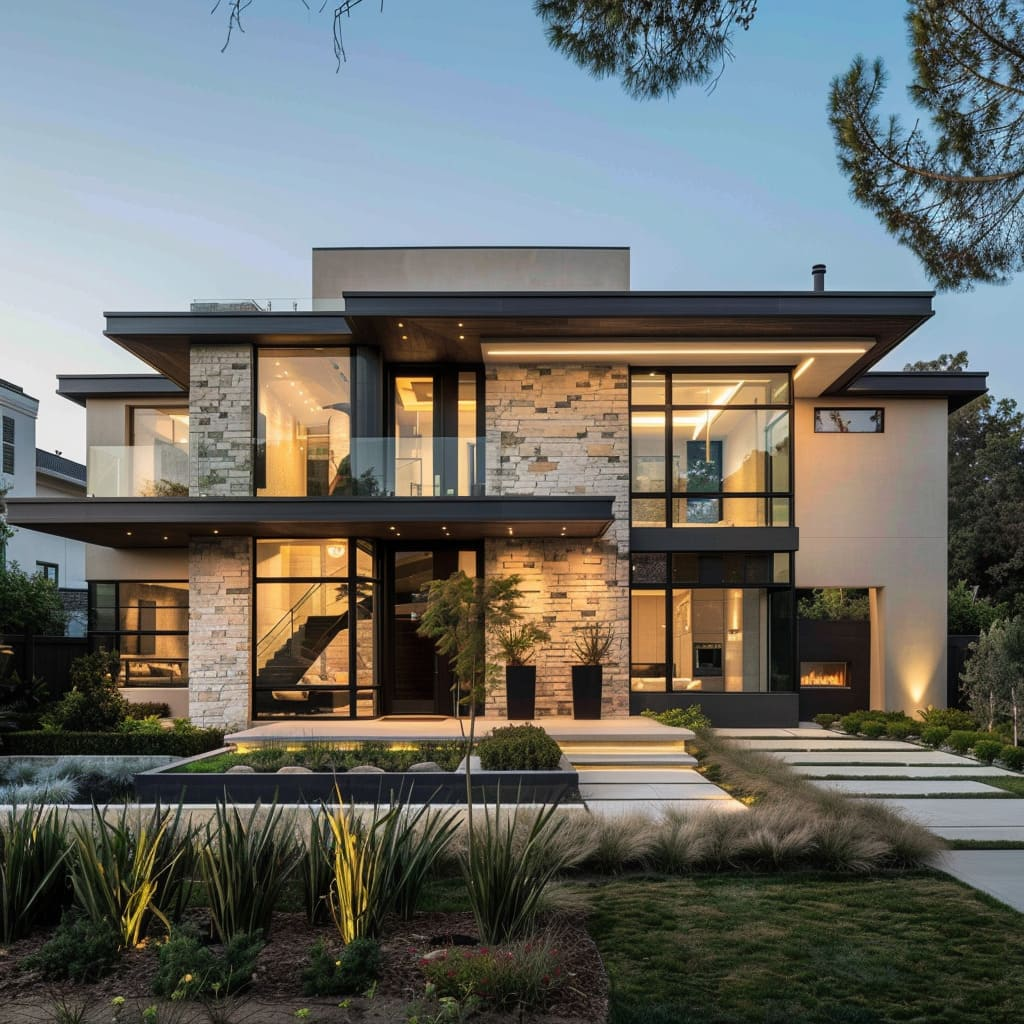
Some exterior walls are crafted with varied materials or colors as accents to highlight architectural features. These accent walls are strategically placed to capture light or be prominently visible from key vantage points.
This technique helps to break up the monotony of larger facades, giving distinct sections of the structure unique identities. It also enables creative expression through diverse materials, such as textured tiles, patterned brickwork, or innovative plaster techniques.
CONTRASTING COLOR FRAMES
Dark window frames create a striking contrast against lighter walls, adding depth and definition to the building’s structure. This design choice not only frames the views but also accentuates the architectural lines, creating a visually engaging pattern.
The dark frames serve as a visual anchor, drawing attention to the windows and highlighting the connection between indoor and outdoor spaces. This contrast enriches the facade and complements the modern materials used throughout the construction.
MODERN FACADE MATERIALS
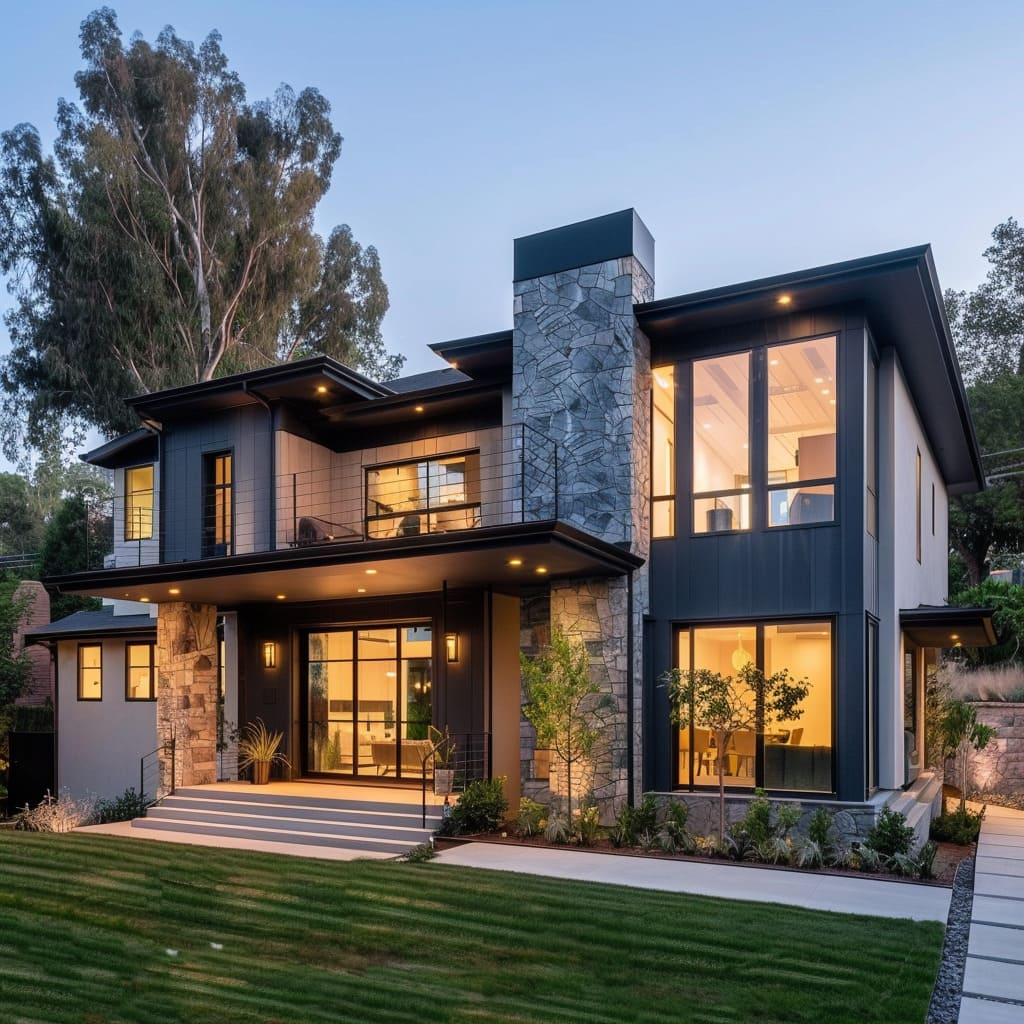
Materials such as stone and wood are incorporated into facades to achieve a contemporary yet earthy aesthetic.
Chosen for their durability and natural beauty, these materials age gracefully, allowing the structures to blend seamlessly with their surroundings. Stone provides sturdy protection against the elements, while wood adds a tactile warmth that enhances visual appeal.
This combination ensures that the buildings not only stand out for their architectural excellence but also feel welcoming and well-integrated into their environment.
FUNCTIONAL AESTHETICS AND USABILITY
In this section, we examine how functionality seamlessly blends with aesthetic appeal in modern home designs. These features ensure that living spaces are both visually striking and highly practical, offering comfort and usability.
INTEGRATED OUTDOOR SEATING
Built-in seating areas in outdoor spaces combine functionality with design, creating a cohesive look that promotes relaxation and enjoyment. Constructed from materials matching the decking or patio, these seating solutions offer aesthetic unity and may include features such as built-in fire pits or water elements.
By providing a permanent outdoor comfort solution, they eliminate the need for additional furniture, making them perfect for both entertaining and unwinding.
GLASS RAILINGS

Balconies and staircases frequently feature glass railings to maintain unobstructed views and a sleek appearance. These railings enhance the modern aesthetic of the home while preserving views of cityscapes or lush backyards.
In addition to their visual appeal, glass railings serve as effective safety features that integrate smoothly with various design styles, from ultra-modern to more traditional, offering a protective barrier without visual bulk.
WALKWAYS AND PATHS
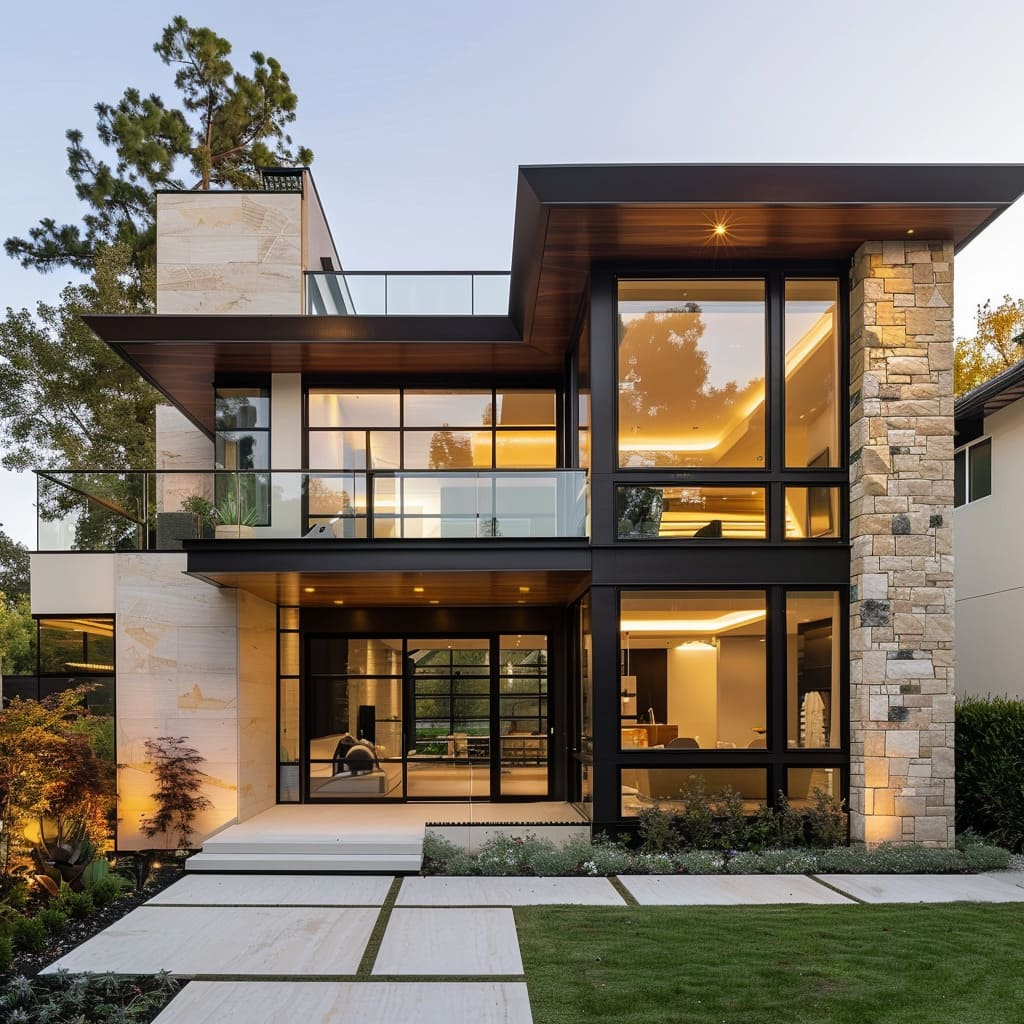
Paved walkways and stepping stones offer structured access through outdoor spaces, improving both usability and visual appeal. Designed with aesthetics and functionality in mind, these pathways often use materials that harmonize with the home’s exterior and landscaping.
They lead visitors on a thoughtfully designed route through the garden, sometimes incorporating curves that promote a leisurely pace and enhance the enjoyment of the surrounding plant life and scenery.
STAIRCASES AS DESIGN FEATURES

Visible staircases through large windows introduce a dynamic vertical element to the otherwise horizontal layout of the home. Often designed as sculptural features, these staircases use materials such as floating wood planks, glass, or sleek metal that complement the home’s architectural style.
Serving both functional and aesthetic purposes, these staircases act as visual connectors between different levels. Positioned next to large windows, they are illuminated by natural light, which changes throughout the day, highlighting their design and adding to their visual impact.
OUTDOOR LIGHTING
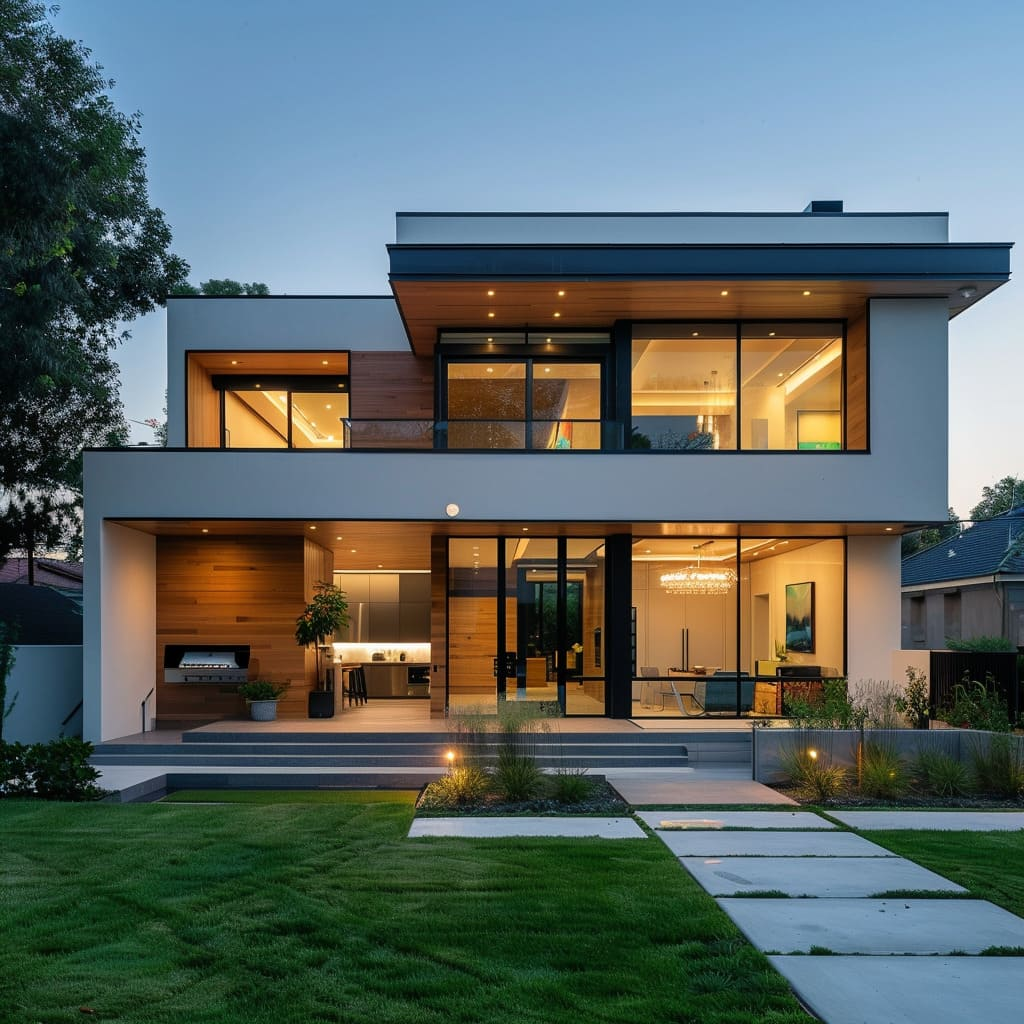
Strategically positioned outdoor lights not only beautifully illuminate homes at night but also accentuate key architectural features. These lighting installations are thoughtfully arranged to highlight significant design elements such as eaves, angles, and the distinctive textures of building materials.
In addition to creating a welcoming ambiance, they improve security by lighting pathways and entry points. Energy-efficient LED lights are often used for their durability and lower environmental impact, aligning with modern home design principles.
CONCLUSION
You’ve hopefully unearthed a treasure trove of inspiration to transform your house into a haven that reflects your unique style and needs. Remember, the best designs are those that blend functionality with aesthetics, creating a space that feels both comfortable and inspiring. Don’t be afraid to experiment, mix and match elements from different styles, and personalize your home with cherished pieces.
The most important aspect? Let your personality shine through! After all, your home is a canvas for your story. So, go forth, embrace these design ideas, and embark on the exciting journey of creating your dream space!

